Analyzing Migration Trends of Nigerians to Developed Countries
VerifiedAdded on 2020/05/16
|65
|16390
|40
AI Summary
The assignment aims to explore the migration trends of Nigerians primarily towards the United States and the United Kingdom. By analyzing various data sources including NOI-Polls and Nigerianstat.gov.ng, this research intends to uncover the underlying reasons for these migratory patterns. A significant emphasis is placed on economic opportunities as a critical factor influencing migration decisions. Furthermore, this study will consider demographic statistics from Statcan.gc.ca to compare employment rates among immigrant populations in Canada, offering a broader perspective on how economic factors influence immigration choices globally. Additionally, qualitative insights from sources such as Nigerian and Canadian immigration studies will be integrated to provide a comprehensive understanding of the socio-economic impacts driving these migration trends.

Table of Contents
Chapter Two: Theoretical/Literature Review..................................................................................2
2.1 Introduction............................................................................................................................2
2.2 Global Immigration Patterns: Implications on immigrants and host countries.........................2
2.3 Situation of Immigration in Canada......................................................................................4
2.3.1 Types of immigrants in Canada......................................................................................7
2.3.2 Trends of immigration population..................................................................................8
2.3.3 Reasons behind immigrations to Canada......................................................................10
2.4 Socio-economic wellbeing Research...................................................................................15
2.5 Country profile (Nigeria).....................................................................................................17
2.4.1 Factors That Compel Nigerian Immigration.................................................................18
2.4.2 Immigration of Nigerian residents to Canada...............................................................23
2.4.3 Obstacles immigrants experience in the Labor Market................................................25
2.5 Theoretical frameworks.......................................................................................................28
2.5.1 The Neo-classical economic approach.........................................................................28
2.5.2 The New Economics of labour Migration (NELM).....................................................30
2.6 Literature Gap......................................................................................................................32
2.7 Conclusion...........................................................................................................................33
Chapter Three: Research Methodology.........................................................................................34
3.1 Introduction..........................................................................................................................34
1
Chapter Two: Theoretical/Literature Review..................................................................................2
2.1 Introduction............................................................................................................................2
2.2 Global Immigration Patterns: Implications on immigrants and host countries.........................2
2.3 Situation of Immigration in Canada......................................................................................4
2.3.1 Types of immigrants in Canada......................................................................................7
2.3.2 Trends of immigration population..................................................................................8
2.3.3 Reasons behind immigrations to Canada......................................................................10
2.4 Socio-economic wellbeing Research...................................................................................15
2.5 Country profile (Nigeria).....................................................................................................17
2.4.1 Factors That Compel Nigerian Immigration.................................................................18
2.4.2 Immigration of Nigerian residents to Canada...............................................................23
2.4.3 Obstacles immigrants experience in the Labor Market................................................25
2.5 Theoretical frameworks.......................................................................................................28
2.5.1 The Neo-classical economic approach.........................................................................28
2.5.2 The New Economics of labour Migration (NELM).....................................................30
2.6 Literature Gap......................................................................................................................32
2.7 Conclusion...........................................................................................................................33
Chapter Three: Research Methodology.........................................................................................34
3.1 Introduction..........................................................................................................................34
1
Paraphrase This Document
Need a fresh take? Get an instant paraphrase of this document with our AI Paraphraser

3.2 Aim of the Research............................................................................................................34
3.3 Study Participants................................................................................................................35
3.4 Research Design..................................................................................................................36
3.5 Research Philosophy............................................................................................................37
3.6 Research Approach..............................................................................................................39
3.7 Research Method.....................................................................................................................40
3.8 Research Strategy................................................................................................................41
3.9 Recruitment technique and study population......................................................................43
3.10 Interview Guide.................................................................................................................44
3.10.1 Developing the Interview Guide.................................................................................45
3.11 Data Collection Sources....................................................................................................46
3.12 Data Collection Process.....................................................................................................47
3.13 Validity and Reliability of Instruments.............................................................................50
3.14 Data Analysis.....................................................................................................................51
3.15 Ethical considerations........................................................................................................53
3.16 Research Challenges and Limitations................................................................................54
3.17 Conclusion.........................................................................................................................55
References......................................................................................................................................56
2
3.3 Study Participants................................................................................................................35
3.4 Research Design..................................................................................................................36
3.5 Research Philosophy............................................................................................................37
3.6 Research Approach..............................................................................................................39
3.7 Research Method.....................................................................................................................40
3.8 Research Strategy................................................................................................................41
3.9 Recruitment technique and study population......................................................................43
3.10 Interview Guide.................................................................................................................44
3.10.1 Developing the Interview Guide.................................................................................45
3.11 Data Collection Sources....................................................................................................46
3.12 Data Collection Process.....................................................................................................47
3.13 Validity and Reliability of Instruments.............................................................................50
3.14 Data Analysis.....................................................................................................................51
3.15 Ethical considerations........................................................................................................53
3.16 Research Challenges and Limitations................................................................................54
3.17 Conclusion.........................................................................................................................55
References......................................................................................................................................56
2
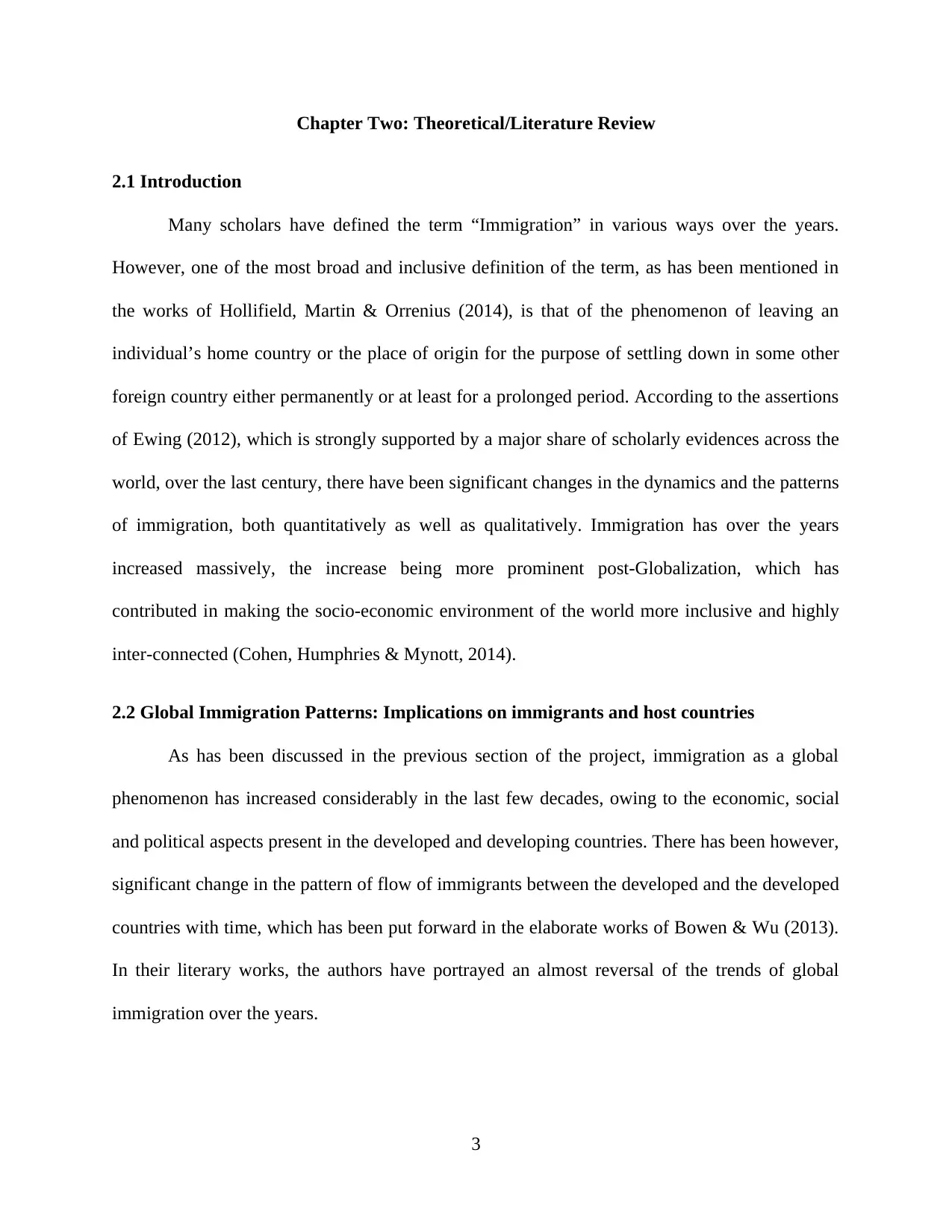
Chapter Two: Theoretical/Literature Review
2.1 Introduction
Many scholars have defined the term “Immigration” in various ways over the years.
However, one of the most broad and inclusive definition of the term, as has been mentioned in
the works of Hollifield, Martin & Orrenius (2014), is that of the phenomenon of leaving an
individual’s home country or the place of origin for the purpose of settling down in some other
foreign country either permanently or at least for a prolonged period. According to the assertions
of Ewing (2012), which is strongly supported by a major share of scholarly evidences across the
world, over the last century, there have been significant changes in the dynamics and the patterns
of immigration, both quantitatively as well as qualitatively. Immigration has over the years
increased massively, the increase being more prominent post-Globalization, which has
contributed in making the socio-economic environment of the world more inclusive and highly
inter-connected (Cohen, Humphries & Mynott, 2014).
2.2 Global Immigration Patterns: Implications on immigrants and host countries
As has been discussed in the previous section of the project, immigration as a global
phenomenon has increased considerably in the last few decades, owing to the economic, social
and political aspects present in the developed and developing countries. There has been however,
significant change in the pattern of flow of immigrants between the developed and the developed
countries with time, which has been put forward in the elaborate works of Bowen & Wu (2013).
In their literary works, the authors have portrayed an almost reversal of the trends of global
immigration over the years.
3
2.1 Introduction
Many scholars have defined the term “Immigration” in various ways over the years.
However, one of the most broad and inclusive definition of the term, as has been mentioned in
the works of Hollifield, Martin & Orrenius (2014), is that of the phenomenon of leaving an
individual’s home country or the place of origin for the purpose of settling down in some other
foreign country either permanently or at least for a prolonged period. According to the assertions
of Ewing (2012), which is strongly supported by a major share of scholarly evidences across the
world, over the last century, there have been significant changes in the dynamics and the patterns
of immigration, both quantitatively as well as qualitatively. Immigration has over the years
increased massively, the increase being more prominent post-Globalization, which has
contributed in making the socio-economic environment of the world more inclusive and highly
inter-connected (Cohen, Humphries & Mynott, 2014).
2.2 Global Immigration Patterns: Implications on immigrants and host countries
As has been discussed in the previous section of the project, immigration as a global
phenomenon has increased considerably in the last few decades, owing to the economic, social
and political aspects present in the developed and developing countries. There has been however,
significant change in the pattern of flow of immigrants between the developed and the developed
countries with time, which has been put forward in the elaborate works of Bowen & Wu (2013).
In their literary works, the authors have portrayed an almost reversal of the trends of global
immigration over the years.
3
⊘ This is a preview!⊘
Do you want full access?
Subscribe today to unlock all pages.

Trusted by 1+ million students worldwide

According to the above-mentioned authors, before 1914, the global immigration policies
were mostly liberal or open and immigration was viewed as one of the primary source of labor
force building and economic development in the countries. The pattern of immigration in the
then global scenario was mostly from the developed to the developing countries. This, supported
by the empirical evidences found in the works of Boswell (2012), shows that during that time,
immigration from one of the most developed places, Europe alone amounted to more than 25
million. This period, was however, followed by a period of limited migration (1920s and 1930s),
which can be primarily attributed to the economic depression in the global scenario and an
ensuing deportation of the migrants.
The trends of migration from developed to developing countries, however, started
shifting gradually post 1945, as suggested by Walton-Roberts (2016). The open policies as well
as economic growth of the developed countries and the scope of a better life in those countries
started attracting people from the developing countries to the same, with the rate being 12% of
the total global immigration. This trend, however, increased significantly by 1973. From this
period, of the total global immigration, nearly 88% started taking place from the developing and
less developed countries to the developed ones. The policies of immigration in the developed
countries remained relatively open but started to incorporate stringent requirements as with time
these countries started facing the issue of increase in the number of refugees and illegal
immigrants Muste (2013). The issue of the increase in the number of illegal immigrants and war
refugees from politically unstable countries, though being primarily experienced by the USA,
Canada was also among those countries facing similar issues and concerns in their immigrant
populations.
4
were mostly liberal or open and immigration was viewed as one of the primary source of labor
force building and economic development in the countries. The pattern of immigration in the
then global scenario was mostly from the developed to the developing countries. This, supported
by the empirical evidences found in the works of Boswell (2012), shows that during that time,
immigration from one of the most developed places, Europe alone amounted to more than 25
million. This period, was however, followed by a period of limited migration (1920s and 1930s),
which can be primarily attributed to the economic depression in the global scenario and an
ensuing deportation of the migrants.
The trends of migration from developed to developing countries, however, started
shifting gradually post 1945, as suggested by Walton-Roberts (2016). The open policies as well
as economic growth of the developed countries and the scope of a better life in those countries
started attracting people from the developing countries to the same, with the rate being 12% of
the total global immigration. This trend, however, increased significantly by 1973. From this
period, of the total global immigration, nearly 88% started taking place from the developing and
less developed countries to the developed ones. The policies of immigration in the developed
countries remained relatively open but started to incorporate stringent requirements as with time
these countries started facing the issue of increase in the number of refugees and illegal
immigrants Muste (2013). The issue of the increase in the number of illegal immigrants and war
refugees from politically unstable countries, though being primarily experienced by the USA,
Canada was also among those countries facing similar issues and concerns in their immigrant
populations.
4
Paraphrase This Document
Need a fresh take? Get an instant paraphrase of this document with our AI Paraphraser

A broad range of demographic, economic and social characteristics is associated with the
lived experience of immigrants to understand their perspective on socio-economic wellbeing in
Canada. Around the world, societies are changing and individuals are on the move: around 250
million people currently live outside their country of origin. This evolving situation presents
opportunities for all concerned: diversity and exchange across national borders provide impetus
for economic, political and social progress – both in host countries and in countries of origin.
Migrants themselves play an important role in building bridges between countries. Through their
expertise, ideas, experience and contacts, they stimulate sustainable change. In a variety of ways,
they help their countries of origin to remain competitive, while simultaneously shaping society in
their host countries.
2.3 Situation of Immigration in Canada
Canada, as one of the developed nations in the global framework, has experienced
significant economic growth and industrial and commercial prosperity over the last century. The
country has a highly productive agricultural sector along with extremely prosperous and
expanding service sector.
The economy of the country has grown consistently over the years, according to the
assertions of the empirically supported literary works of many scholars across the globe.
Southcott & Walker (2015), for instance, in their extensive working paper, suggests that much of
the economic prosperity of the country over the years has contributed positively to the overall
quality of lives of the residents of the country, by increasing their economic, social and overall
welfare. This assertion, is both theoretically and empirically supported by the findings of the
5
lived experience of immigrants to understand their perspective on socio-economic wellbeing in
Canada. Around the world, societies are changing and individuals are on the move: around 250
million people currently live outside their country of origin. This evolving situation presents
opportunities for all concerned: diversity and exchange across national borders provide impetus
for economic, political and social progress – both in host countries and in countries of origin.
Migrants themselves play an important role in building bridges between countries. Through their
expertise, ideas, experience and contacts, they stimulate sustainable change. In a variety of ways,
they help their countries of origin to remain competitive, while simultaneously shaping society in
their host countries.
2.3 Situation of Immigration in Canada
Canada, as one of the developed nations in the global framework, has experienced
significant economic growth and industrial and commercial prosperity over the last century. The
country has a highly productive agricultural sector along with extremely prosperous and
expanding service sector.
The economy of the country has grown consistently over the years, according to the
assertions of the empirically supported literary works of many scholars across the globe.
Southcott & Walker (2015), for instance, in their extensive working paper, suggests that much of
the economic prosperity of the country over the years has contributed positively to the overall
quality of lives of the residents of the country, by increasing their economic, social and overall
welfare. This assertion, is both theoretically and empirically supported by the findings of the
5

Center For The Study of Living Standards, which tries to link the economic growth of Canada
over the years, with the economic well being of the residents of the country, as can be seen from
the following figure:
Figure 3: Increase in the Index of Economic Well-being with the increase in per-capita
GDP
(Source: Csls.ca, 2018)
The index of economic well-being is an economic tool for the measurement of the overall
prosperity and economic stability enjoyed by the population in general of a particular country at
a specific point of time. Thus, from the above figure, it can be clearly asserted that, Canada over
the years has experienced a visible increase in its per-capita GDP, which in turn can be positively
linked to the economic well-being of the residents of the country, which is also seen to be
increasing mostly at par with the per-capita GDP of the country.
6
over the years, with the economic well being of the residents of the country, as can be seen from
the following figure:
Figure 3: Increase in the Index of Economic Well-being with the increase in per-capita
GDP
(Source: Csls.ca, 2018)
The index of economic well-being is an economic tool for the measurement of the overall
prosperity and economic stability enjoyed by the population in general of a particular country at
a specific point of time. Thus, from the above figure, it can be clearly asserted that, Canada over
the years has experienced a visible increase in its per-capita GDP, which in turn can be positively
linked to the economic well-being of the residents of the country, which is also seen to be
increasing mostly at par with the per-capita GDP of the country.
6
⊘ This is a preview!⊘
Do you want full access?
Subscribe today to unlock all pages.

Trusted by 1+ million students worldwide
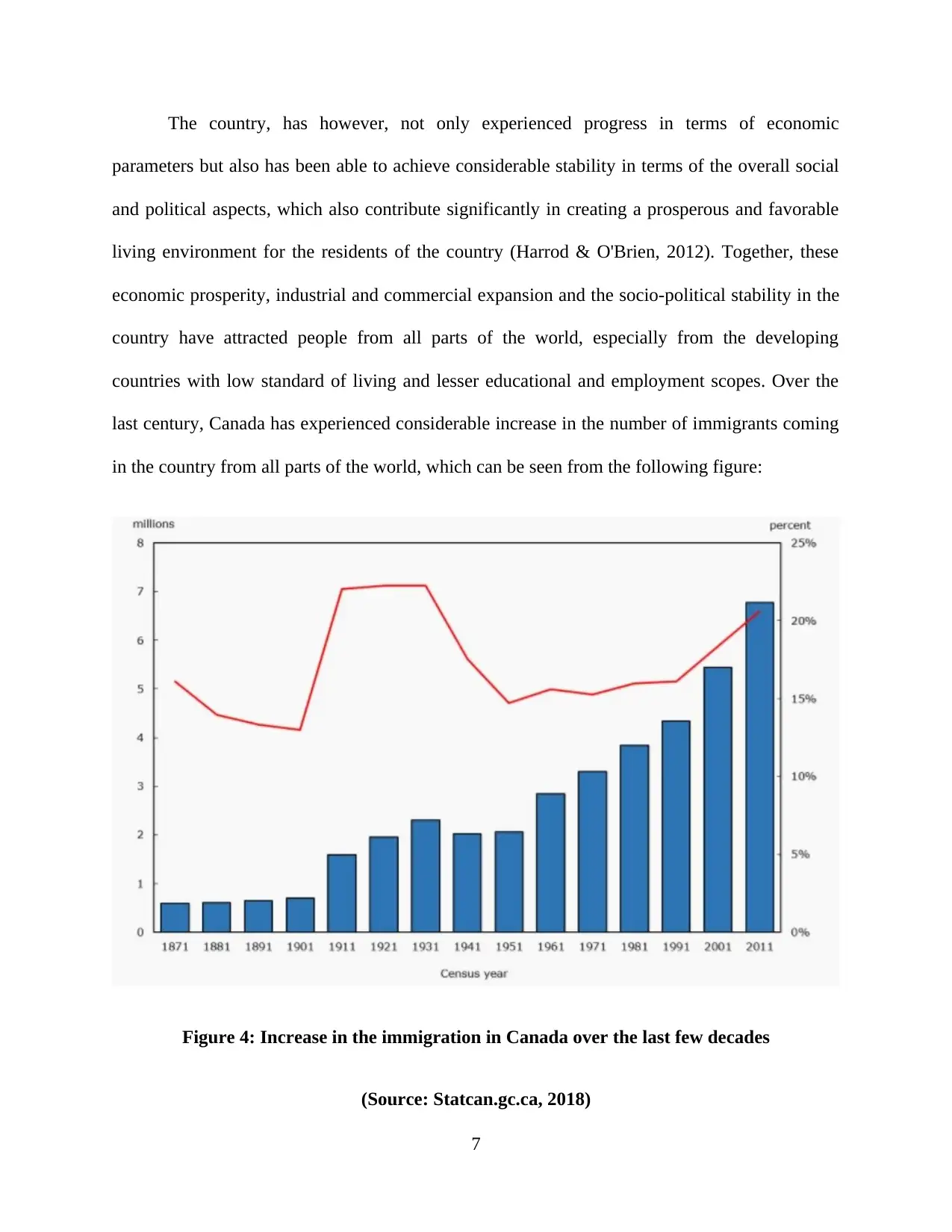
The country, has however, not only experienced progress in terms of economic
parameters but also has been able to achieve considerable stability in terms of the overall social
and political aspects, which also contribute significantly in creating a prosperous and favorable
living environment for the residents of the country (Harrod & O'Brien, 2012). Together, these
economic prosperity, industrial and commercial expansion and the socio-political stability in the
country have attracted people from all parts of the world, especially from the developing
countries with low standard of living and lesser educational and employment scopes. Over the
last century, Canada has experienced considerable increase in the number of immigrants coming
in the country from all parts of the world, which can be seen from the following figure:
Figure 4: Increase in the immigration in Canada over the last few decades
(Source: Statcan.gc.ca, 2018)
7
parameters but also has been able to achieve considerable stability in terms of the overall social
and political aspects, which also contribute significantly in creating a prosperous and favorable
living environment for the residents of the country (Harrod & O'Brien, 2012). Together, these
economic prosperity, industrial and commercial expansion and the socio-political stability in the
country have attracted people from all parts of the world, especially from the developing
countries with low standard of living and lesser educational and employment scopes. Over the
last century, Canada has experienced considerable increase in the number of immigrants coming
in the country from all parts of the world, which can be seen from the following figure:
Figure 4: Increase in the immigration in Canada over the last few decades
(Source: Statcan.gc.ca, 2018)
7
Paraphrase This Document
Need a fresh take? Get an instant paraphrase of this document with our AI Paraphraser
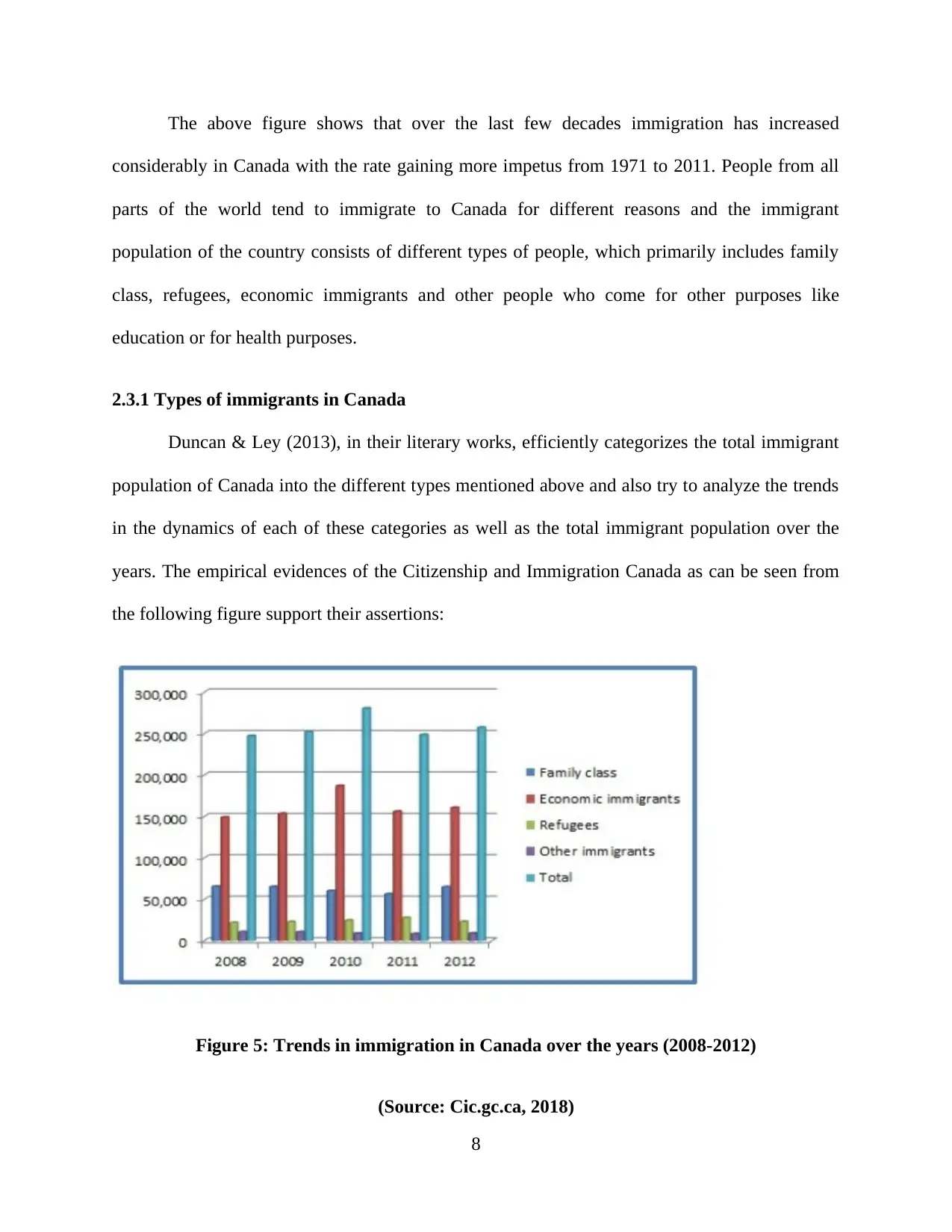
The above figure shows that over the last few decades immigration has increased
considerably in Canada with the rate gaining more impetus from 1971 to 2011. People from all
parts of the world tend to immigrate to Canada for different reasons and the immigrant
population of the country consists of different types of people, which primarily includes family
class, refugees, economic immigrants and other people who come for other purposes like
education or for health purposes.
2.3.1 Types of immigrants in Canada
Duncan & Ley (2013), in their literary works, efficiently categorizes the total immigrant
population of Canada into the different types mentioned above and also try to analyze the trends
in the dynamics of each of these categories as well as the total immigrant population over the
years. The empirical evidences of the Citizenship and Immigration Canada as can be seen from
the following figure support their assertions:
Figure 5: Trends in immigration in Canada over the years (2008-2012)
(Source: Cic.gc.ca, 2018)
8
considerably in Canada with the rate gaining more impetus from 1971 to 2011. People from all
parts of the world tend to immigrate to Canada for different reasons and the immigrant
population of the country consists of different types of people, which primarily includes family
class, refugees, economic immigrants and other people who come for other purposes like
education or for health purposes.
2.3.1 Types of immigrants in Canada
Duncan & Ley (2013), in their literary works, efficiently categorizes the total immigrant
population of Canada into the different types mentioned above and also try to analyze the trends
in the dynamics of each of these categories as well as the total immigrant population over the
years. The empirical evidences of the Citizenship and Immigration Canada as can be seen from
the following figure support their assertions:
Figure 5: Trends in immigration in Canada over the years (2008-2012)
(Source: Cic.gc.ca, 2018)
8
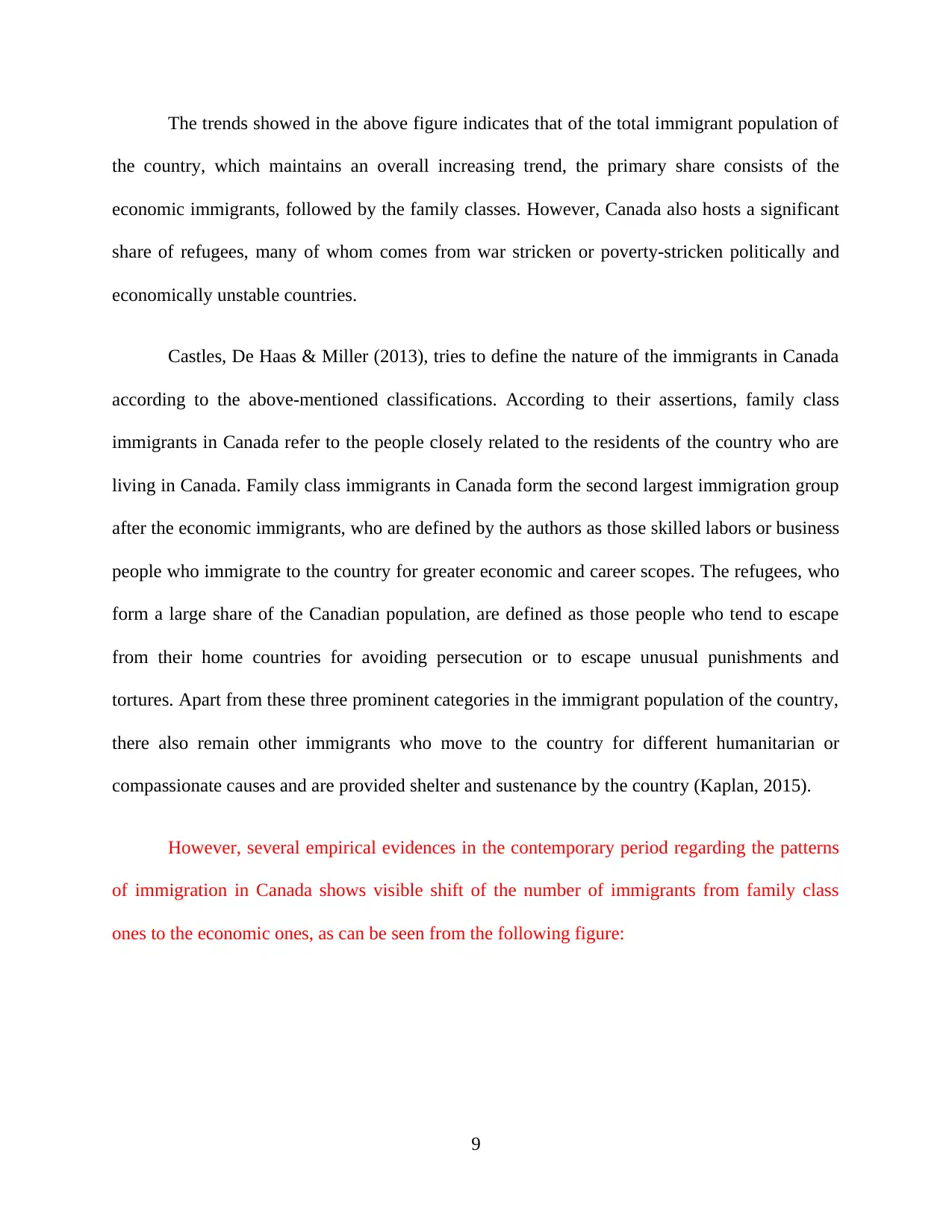
The trends showed in the above figure indicates that of the total immigrant population of
the country, which maintains an overall increasing trend, the primary share consists of the
economic immigrants, followed by the family classes. However, Canada also hosts a significant
share of refugees, many of whom comes from war stricken or poverty-stricken politically and
economically unstable countries.
Castles, De Haas & Miller (2013), tries to define the nature of the immigrants in Canada
according to the above-mentioned classifications. According to their assertions, family class
immigrants in Canada refer to the people closely related to the residents of the country who are
living in Canada. Family class immigrants in Canada form the second largest immigration group
after the economic immigrants, who are defined by the authors as those skilled labors or business
people who immigrate to the country for greater economic and career scopes. The refugees, who
form a large share of the Canadian population, are defined as those people who tend to escape
from their home countries for avoiding persecution or to escape unusual punishments and
tortures. Apart from these three prominent categories in the immigrant population of the country,
there also remain other immigrants who move to the country for different humanitarian or
compassionate causes and are provided shelter and sustenance by the country (Kaplan, 2015).
However, several empirical evidences in the contemporary period regarding the patterns
of immigration in Canada shows visible shift of the number of immigrants from family class
ones to the economic ones, as can be seen from the following figure:
9
the country, which maintains an overall increasing trend, the primary share consists of the
economic immigrants, followed by the family classes. However, Canada also hosts a significant
share of refugees, many of whom comes from war stricken or poverty-stricken politically and
economically unstable countries.
Castles, De Haas & Miller (2013), tries to define the nature of the immigrants in Canada
according to the above-mentioned classifications. According to their assertions, family class
immigrants in Canada refer to the people closely related to the residents of the country who are
living in Canada. Family class immigrants in Canada form the second largest immigration group
after the economic immigrants, who are defined by the authors as those skilled labors or business
people who immigrate to the country for greater economic and career scopes. The refugees, who
form a large share of the Canadian population, are defined as those people who tend to escape
from their home countries for avoiding persecution or to escape unusual punishments and
tortures. Apart from these three prominent categories in the immigrant population of the country,
there also remain other immigrants who move to the country for different humanitarian or
compassionate causes and are provided shelter and sustenance by the country (Kaplan, 2015).
However, several empirical evidences in the contemporary period regarding the patterns
of immigration in Canada shows visible shift of the number of immigrants from family class
ones to the economic ones, as can be seen from the following figure:
9
⊘ This is a preview!⊘
Do you want full access?
Subscribe today to unlock all pages.

Trusted by 1+ million students worldwide
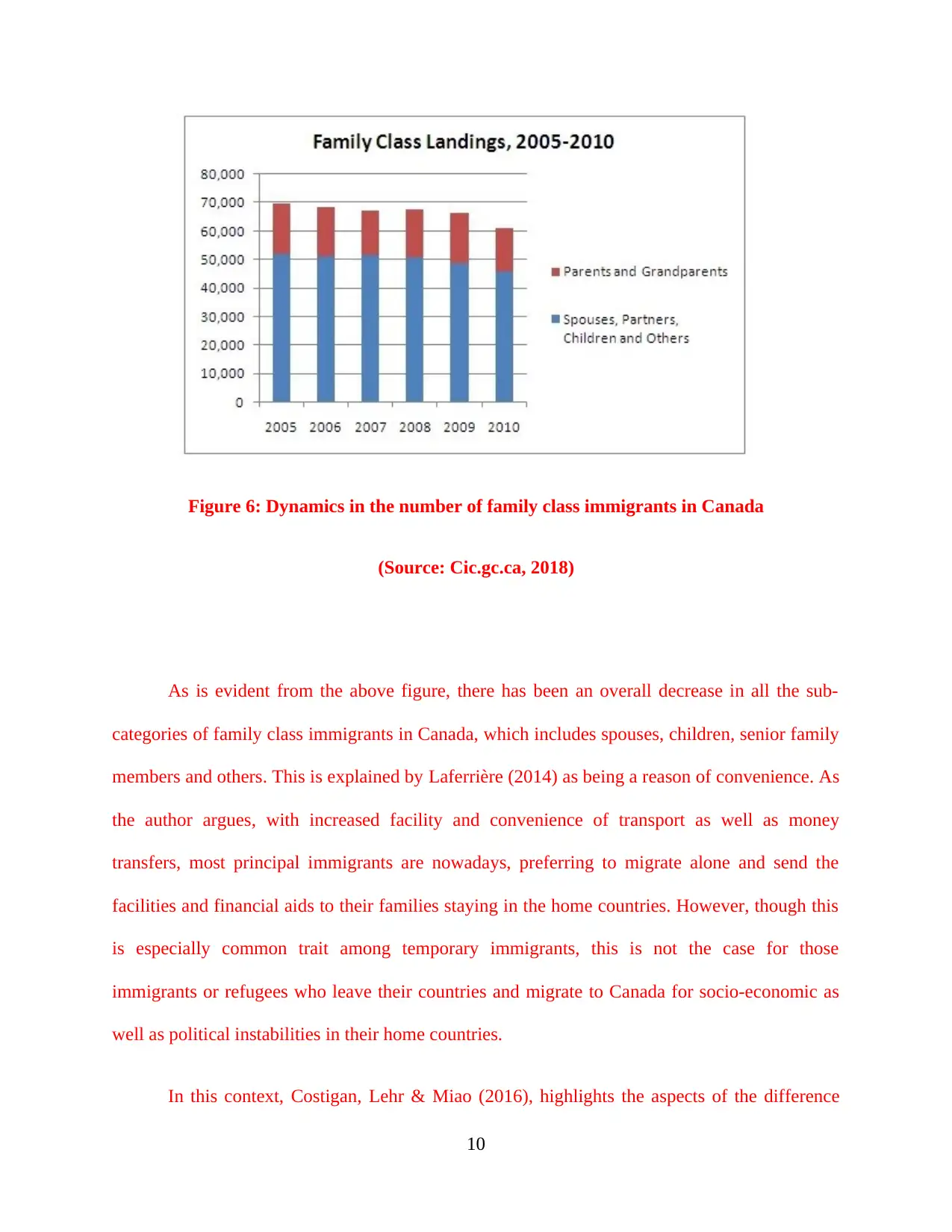
Figure 6: Dynamics in the number of family class immigrants in Canada
(Source: Cic.gc.ca, 2018)
As is evident from the above figure, there has been an overall decrease in all the sub-
categories of family class immigrants in Canada, which includes spouses, children, senior family
members and others. This is explained by Laferrière (2014) as being a reason of convenience. As
the author argues, with increased facility and convenience of transport as well as money
transfers, most principal immigrants are nowadays, preferring to migrate alone and send the
facilities and financial aids to their families staying in the home countries. However, though this
is especially common trait among temporary immigrants, this is not the case for those
immigrants or refugees who leave their countries and migrate to Canada for socio-economic as
well as political instabilities in their home countries.
In this context, Costigan, Lehr & Miao (2016), highlights the aspects of the difference
10
(Source: Cic.gc.ca, 2018)
As is evident from the above figure, there has been an overall decrease in all the sub-
categories of family class immigrants in Canada, which includes spouses, children, senior family
members and others. This is explained by Laferrière (2014) as being a reason of convenience. As
the author argues, with increased facility and convenience of transport as well as money
transfers, most principal immigrants are nowadays, preferring to migrate alone and send the
facilities and financial aids to their families staying in the home countries. However, though this
is especially common trait among temporary immigrants, this is not the case for those
immigrants or refugees who leave their countries and migrate to Canada for socio-economic as
well as political instabilities in their home countries.
In this context, Costigan, Lehr & Miao (2016), highlights the aspects of the difference
10
Paraphrase This Document
Need a fresh take? Get an instant paraphrase of this document with our AI Paraphraser

between the two major types of immigrants coming down to Canada over the years, with respect
to their nature of activities and level of dependency. These two broad sub-groups of the total
immigrant population in Canada are namely the principal immigrants and the dependent
immigrants. As per the assertions of Pratt (2015), the principal immigrants are those immigrants
who apply as the beneficiary of the visa petition to the country he or she is immigrating from his
or her home country. On the other hand, dependent immigrants are those who come with and as
responsibilities of the principal applicant for immigration in the country.
Figure 7: Male and female principal immigrants in Canada over the years (2005-2015)
(Source: Immigration, 2018)
As can be seen from the above figure, the number of female principal immigrants in
Canada has increased considerably over the last few years, thereby reducing the considerably
high existing gap between male and female principal immigrants in the country. To be specific,
the gap has reduced by 55% from 2005 to 2015, which in turn indicates towards the fact that the
country has been taking robust and effective strategies for recognition of the importance of
11
to their nature of activities and level of dependency. These two broad sub-groups of the total
immigrant population in Canada are namely the principal immigrants and the dependent
immigrants. As per the assertions of Pratt (2015), the principal immigrants are those immigrants
who apply as the beneficiary of the visa petition to the country he or she is immigrating from his
or her home country. On the other hand, dependent immigrants are those who come with and as
responsibilities of the principal applicant for immigration in the country.
Figure 7: Male and female principal immigrants in Canada over the years (2005-2015)
(Source: Immigration, 2018)
As can be seen from the above figure, the number of female principal immigrants in
Canada has increased considerably over the last few years, thereby reducing the considerably
high existing gap between male and female principal immigrants in the country. To be specific,
the gap has reduced by 55% from 2005 to 2015, which in turn indicates towards the fact that the
country has been taking robust and effective strategies for recognition of the importance of
11
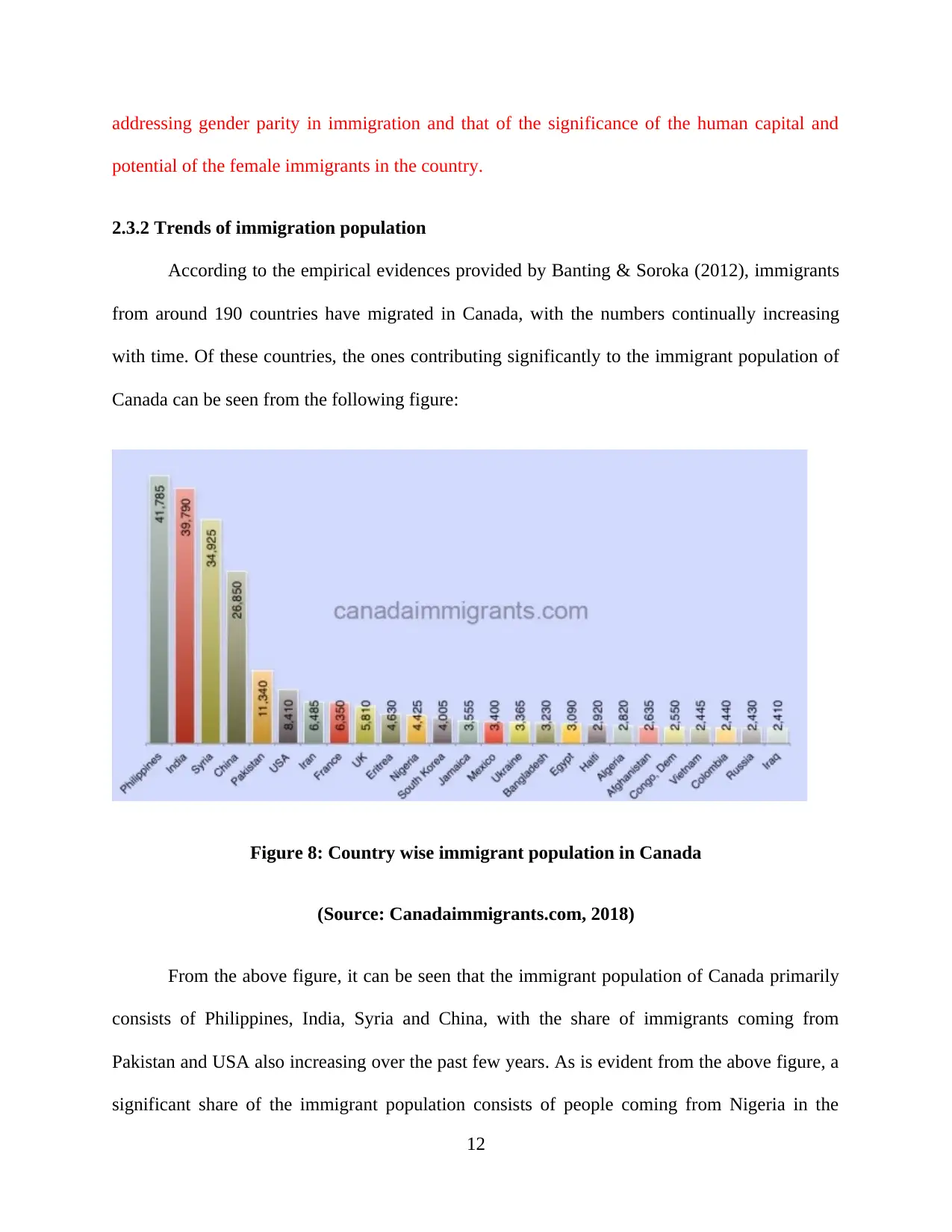
addressing gender parity in immigration and that of the significance of the human capital and
potential of the female immigrants in the country.
2.3.2 Trends of immigration population
According to the empirical evidences provided by Banting & Soroka (2012), immigrants
from around 190 countries have migrated in Canada, with the numbers continually increasing
with time. Of these countries, the ones contributing significantly to the immigrant population of
Canada can be seen from the following figure:
Figure 8: Country wise immigrant population in Canada
(Source: Canadaimmigrants.com, 2018)
From the above figure, it can be seen that the immigrant population of Canada primarily
consists of Philippines, India, Syria and China, with the share of immigrants coming from
Pakistan and USA also increasing over the past few years. As is evident from the above figure, a
significant share of the immigrant population consists of people coming from Nigeria in the
12
potential of the female immigrants in the country.
2.3.2 Trends of immigration population
According to the empirical evidences provided by Banting & Soroka (2012), immigrants
from around 190 countries have migrated in Canada, with the numbers continually increasing
with time. Of these countries, the ones contributing significantly to the immigrant population of
Canada can be seen from the following figure:
Figure 8: Country wise immigrant population in Canada
(Source: Canadaimmigrants.com, 2018)
From the above figure, it can be seen that the immigrant population of Canada primarily
consists of Philippines, India, Syria and China, with the share of immigrants coming from
Pakistan and USA also increasing over the past few years. As is evident from the above figure, a
significant share of the immigrant population consists of people coming from Nigeria in the
12
⊘ This is a preview!⊘
Do you want full access?
Subscribe today to unlock all pages.

Trusted by 1+ million students worldwide
1 out of 65
Related Documents
Your All-in-One AI-Powered Toolkit for Academic Success.
+13062052269
info@desklib.com
Available 24*7 on WhatsApp / Email
![[object Object]](/_next/static/media/star-bottom.7253800d.svg)
Unlock your academic potential
Copyright © 2020–2025 A2Z Services. All Rights Reserved. Developed and managed by ZUCOL.





